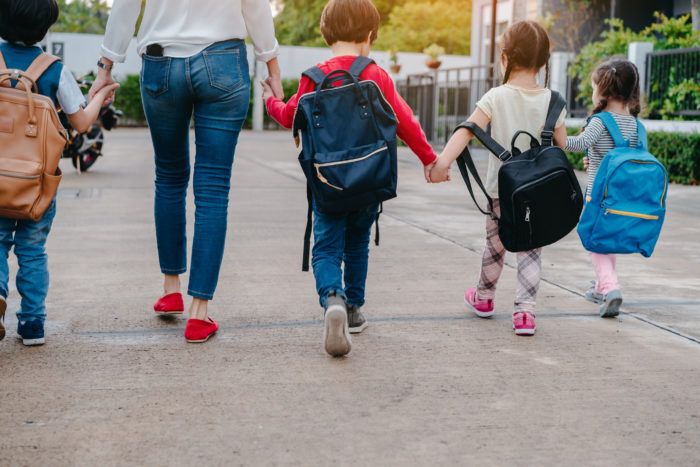What Are Important Factors for Back Pack Safety? — Returning to School
Many students returned to school in August with new kicks, cool clothes and hip backpacks. Backpacks today come in all shapes and sizes, in varying materials that range from canvas to leather to metallic, and some resemble cute animals, with ears and tails and all. Children can show off their personalities by selecting their particular styles. But the most important thing to remember about backpacks is what is carried in them.
“When you move your child’s backpack after he or she drops it at the door, does it feel like it contains 40 pounds of rocks?” reads an article by the National Safety Council titled “Backpack Safety: It’s Time to Lighten the Load.” “Maybe you’ve noticed your child struggling to put it on, bending forward while carrying it, or complaining of tingling or numbness. If you’ve been concerned about the effects that extra weight might have on your child’s still-growing body, your instincts are correct.”
The National Safety Council recommends paying attention to these factors when selecting a backpack:
- An ergonomic design
- The correct size: never wider or longer than your child’s torso and never hanging more than 4 inches below the waist
- Padded back and shoulder straps
- Hip and chest belts to help transfer some of the weight to the hips and torso
- Multiple compartments to better distribute the weight
- Compression straps on the sides or bottom to stabilize the contents
- Reflective material
- Backpack should weigh no more than 5% to 10% of a child’s weight
If a child is carrying too much weight, it can lead to neck and shoulder pain, poor posture and lower-back problems that will continue to worsen. Lugging laptops and other digital devices, as well as notebooks and textbooks, often has children carrying up to one-quarter of their body weight.
“Back pain is pervasive among American adults, however it is not uncommon among children and teens either,” according to the American Chiropractic Association. “In a new and disturbing trend, young children are suffering from back pain much earlier than previous generations, and the use of overweight backpacks is a contributing factor.…”
The association recommends that only 10 percent – and ideally five percent – of a child’s bodyweight should be carried. Also, a backpack should not hang too far below the waistline, as that causes stressful leaning.
“This new back pain trend among youngsters isn’t surprising when you consider the disproportionate amounts of weight they carry in their backpacks – often slung over just one shoulder,” according to the association. “The problem has become so widespread, in fact, that some states have passed legislation that would force school districts to develop ways of reducing the weight of students’ backpacks.”
Meantime, form must meet fashion, so youths do not injure themselves prematurely. Backpacks should be light when empty, so maybe canvas as opposed to leather is a better choice. They should have two padded straps and a padded back and, for extra safety, a waist strap. Compartments can help distribute weight around the backpack and therefore the body.
“Picking up the backpack the right way can help kids avoid back injuries,” according to KidsHealth. “As with any heavy weight, they should bend at the knees and grab the pack with both hands when lifting a backpack to the shoulders.”
Bulky backpacks can cause other injuries besides physical strain. They are tripping hazards in hallways, they bump into everything on the bus, and they can lead to falls.
“Carrying a heavy pack changes the way kids walk and puts them at risk of falling, particularly on stairs or other places where a backpack puts a student off balance,” according to KidsHealth. “Despite their potential problems, backpacks are great when used properly.”
Here are tips parents can follow to ensure the health and well-being of their children this school year.
- Ask children whether they are experiencing discomfort, numbness, tingling or any other symptoms.
- Teach children how to properly put on their backpacks – and take them off – so it is less of a struggle.
“Children have all sorts of creative ways of wearing their backpacks,” according to a Backpack Safety America blog. “Mostly, you’ll see backpacks dangling by one shoulder strap, hanging so low that they rest on the child’s bottom, pulling shoulders and spine far from their natural and healthy upright posture. Using both shoulder straps and the waist strap and wearing the pack in the middle of the child’s back are still the best way to do it.”
- Explain to children they can carry some of their textbooks in their arms instead of piling all of them in their backpacks.
- Encourage children to go to their lockers between classes so they carry only the textbooks they need.
- Consider investing in a second set of textbooks so that one set can be kept at home.
- Consult with a physical therapist.
“A physical therapist can help you choose a proper backpack and fit it specifically to your child,” according to Move Forward, the American Physical Therapy Association’s Web site. “Children come in all shapes and sizes, and some have physical limitations that require special adaptations. Additionally, a physical therapist can help improve posture problems, correct muscle imbalances, and treat pain that can result from improper backpack use. Physical therapists can also design individualized fitness programs to help children get strong and stay strong – and carry their own loads!”
Share This



